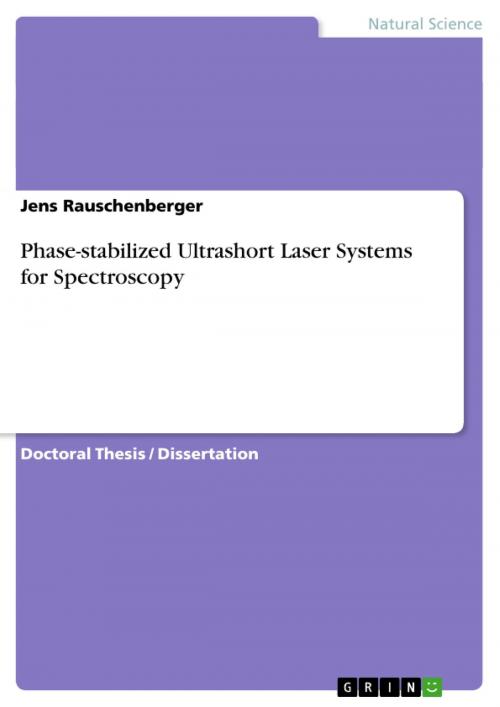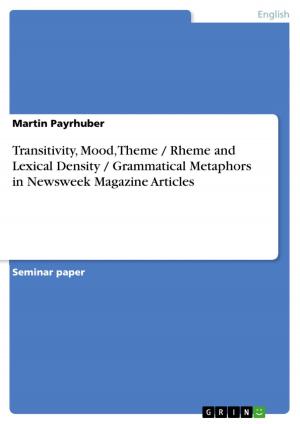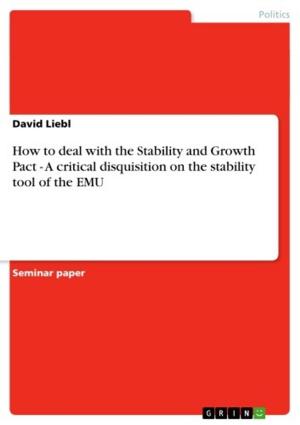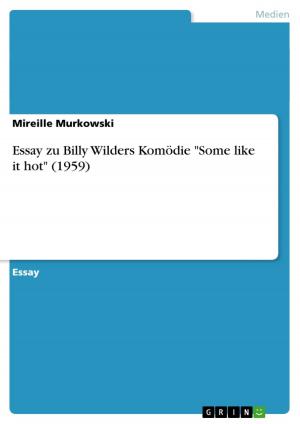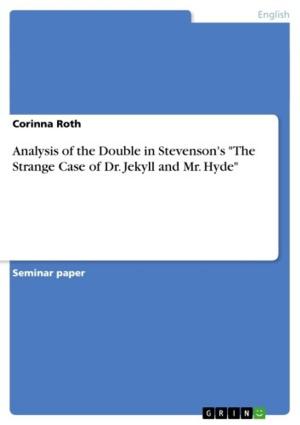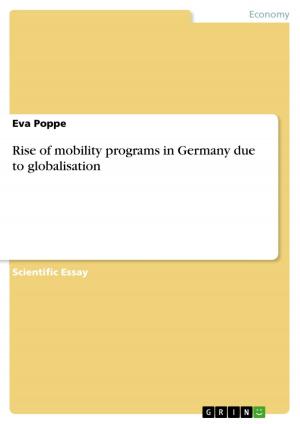Phase-stabilized Ultrashort Laser Systems for Spectroscopy
Nonfiction, Science & Nature, Science, Physics, General Physics| Author: | Jens Rauschenberger | ISBN: | 9783640096985 |
| Publisher: | GRIN Publishing | Publication: | July 7, 2008 |
| Imprint: | GRIN Publishing | Language: | English |
| Author: | Jens Rauschenberger |
| ISBN: | 9783640096985 |
| Publisher: | GRIN Publishing |
| Publication: | July 7, 2008 |
| Imprint: | GRIN Publishing |
| Language: | English |
Doctoral Thesis / Dissertation from the year 2007 in the subject Physics - Theoretical Physics, grade: 1,0, LMU Munich (Max-Planck-Institut für Quantenoptik), 193 entries in the bibliography, language: English, abstract: The investigation of laser-matter interactions calls for ever shorter pulses as new effects can thus be explored. With laser pulses consisting of only a few cycles of the electric field, the phase of these electric field oscillations becomes important for many applications. In this thesis ultrafast laser sources are presented that provide few-cycle laser pulses with controlled evolution of the electric field waveform. Firstly, a technique for phasestabilizing ultra-broadband oscillators is discussed. With a simple setup it improves the reproducibility of the phase by an order of magnitude compared to previously existing methods. In a further step, such a phase-stabilized oscillator was integrated into a chirped-pulse amplifier. The preservation of phase-stability during amplification is ensured by secondary phase detection. The phase-stabilized intense laser pulses from this system were employed in a series of experiments that studied strong-field phenomena in a time-resolved manner. For instance, the laser-induced tunneling of electrons from atoms was studied on a sub-femtosecond timescale. Additional evidence for the reproducibility of the electric field waveform of the laser pulses is presented here: individual signatures of the electric field half-cycles were found in photoelectron spectra from above-threshold ionization. Frequency conversion of intense laser pulses by high-order harmonic generation is a common way of producing coherent light in the extreme ultraviolet (XUV) spectral region. Many attempts have been made to increase the low efficiency of this nonlinear process, e.g. by quasi phase-matching. Here, high-harmonic generation from solid surfaces under grazing incidence instead from a gas target is studied as higher efficiencies are expected in this configuration. Another approach to increasing the efficiency of high-harmonic generation is the placing of the gas target in an enhancement resonator. Additionally, the production of XUV photons happens at the full repetition rate of the seeding laser, i.e. in the region of several tens to hundreds of megahertz. This high repetition rate enables the use of the XUV light for high-precision optical frequency metrology with the frequency comb technique. With such an arrangement, harmonics up to 15th order were produced. A build-up cavity that stacks femtosecond laser pulses in a coherent manner to produce intra-cavity pulse energies of more than ten microjoules at a repetition rate of ten megahertz is presented here...
Doctoral Thesis / Dissertation from the year 2007 in the subject Physics - Theoretical Physics, grade: 1,0, LMU Munich (Max-Planck-Institut für Quantenoptik), 193 entries in the bibliography, language: English, abstract: The investigation of laser-matter interactions calls for ever shorter pulses as new effects can thus be explored. With laser pulses consisting of only a few cycles of the electric field, the phase of these electric field oscillations becomes important for many applications. In this thesis ultrafast laser sources are presented that provide few-cycle laser pulses with controlled evolution of the electric field waveform. Firstly, a technique for phasestabilizing ultra-broadband oscillators is discussed. With a simple setup it improves the reproducibility of the phase by an order of magnitude compared to previously existing methods. In a further step, such a phase-stabilized oscillator was integrated into a chirped-pulse amplifier. The preservation of phase-stability during amplification is ensured by secondary phase detection. The phase-stabilized intense laser pulses from this system were employed in a series of experiments that studied strong-field phenomena in a time-resolved manner. For instance, the laser-induced tunneling of electrons from atoms was studied on a sub-femtosecond timescale. Additional evidence for the reproducibility of the electric field waveform of the laser pulses is presented here: individual signatures of the electric field half-cycles were found in photoelectron spectra from above-threshold ionization. Frequency conversion of intense laser pulses by high-order harmonic generation is a common way of producing coherent light in the extreme ultraviolet (XUV) spectral region. Many attempts have been made to increase the low efficiency of this nonlinear process, e.g. by quasi phase-matching. Here, high-harmonic generation from solid surfaces under grazing incidence instead from a gas target is studied as higher efficiencies are expected in this configuration. Another approach to increasing the efficiency of high-harmonic generation is the placing of the gas target in an enhancement resonator. Additionally, the production of XUV photons happens at the full repetition rate of the seeding laser, i.e. in the region of several tens to hundreds of megahertz. This high repetition rate enables the use of the XUV light for high-precision optical frequency metrology with the frequency comb technique. With such an arrangement, harmonics up to 15th order were produced. A build-up cavity that stacks femtosecond laser pulses in a coherent manner to produce intra-cavity pulse energies of more than ten microjoules at a repetition rate of ten megahertz is presented here...
